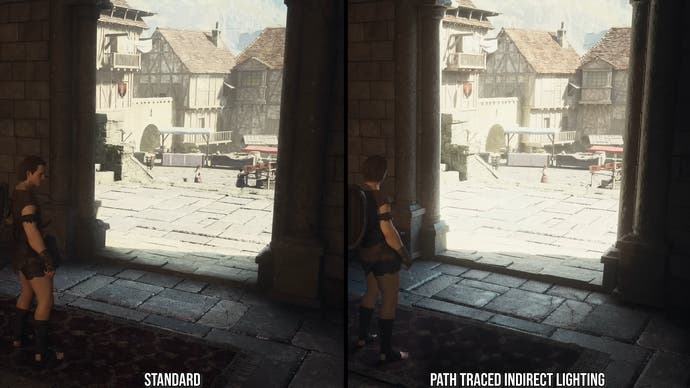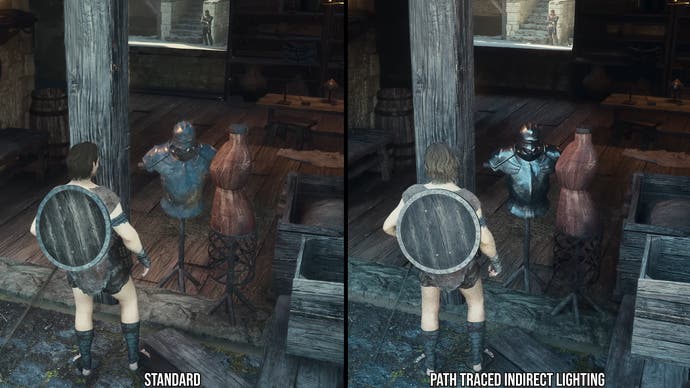Path tracing? In Dragon's Dogma 2? The game shipped with ray-traced global illumination but a path tracer sits within Capcom's code – exposed thanks to a new mod for the PC version of the game. Graphics Suite Alpha, made by developer EXXXCellent, is available on Nexus Mods and includes path-traced lighting, shadows and reflections, all running in real-time. So, how does it look, how well does it run – and why exactly is it there in the first place?
To install the mod, you'll also need the most recent REFramework tool from Github, extract that into the Dragon's Dogma 2 install directory, then add in the mod's Lua script to the autorun folder. Go in-game, and you should have access to a bunch of additional options at the bottom of the REFramework overlay related to RT and path tracing.
With PT enabled, you'll see significantly more material and lighting detail versus the standard ray-traced global illumination (RTGI) with the option to use a per-pixel or four-samples-per-pixel level of granularity – each with a corresponding performance cost, of course. The standard RTGI has significantly less information to work with – one sample for every four pixels, so it has a lot more compromises compared to the 'ground truth' of path tracing.
Another reason the path-traced version of the game looks better is because it includes specular light paths, or reflections. This can make a big difference to the appearance of shiny objects like suits of armor, where the standard RTGI doesn't look realistic – it can look splotchy and glows oddly. In comparison, the same piece of armor with path tracing enabled looks like metal, with real-time reflections and self occlusion. This addition of proper reflectivity greatly enhances a wide range of the game's materials and textures with proper coloring and shading, and makes differentiation between materials like glass, wood, stone and metal easier too.
The game world is also enhanced with path-traced shadows, which replace the lower resolution (and sometimes temporarily unstable) shadow maps found in the standard presentation. This allows for much higher shadow detail to match the relatively complex geometry on structures and other areas – and as shadows are done on a per-pixel basis rather than on a projected grid, there's much less fizzle, pop-in and jittering too. Finally, there are just more shadows in general with path tracing enabled, with smaller light-emitting sources like candles now casting shadows to ratchet up the detail in many indoor scenes.
Given how much the game's visual fidelity is improved by enabling PT, it's surprising that a single modder could have accomplished so much – so what's the catch? The answer may already have been obvious to some readers from the video or screenshots on this page: this mod adds path tracing without any kind of denoising step.

Without a denoiser, there's a 'film grain' of sorts visible almost everywhere. And rather than being a static texture, this film grain is constantly crawling, making it significantly more noticeable. This is the noise that normally would be removed or at least heavily minimized in a game with official path tracing support, like Cyberpunk 2077.
Furthermore, we can see from the debug overlay that the mod essentially enables an extra option already hidden in the game, letting you swap from 'ASVGF' – a kind of denoising filter used for global illumination – to 'pure path tracing'. I think this mode was most likely used by Dragon's Dogma 2's developers for graphics reference work. It's becoming increasingly common for graphics programmers to implement path tracing into game engines to check lighting or material quality while developing the real-time graphics engine; Essentially path tracing serves as a 'ground truth' that can be checked against. Sometimes these hidden path tracers have denoising, like in Unreal Engine 5, but sometimes they do not, as seems to be the case here.
Given that path tracing was never intended to be an option for gameplay, it's not surprising that the path tracing implementation has some fairly major drawbacks. Beyond lacking a denoiser, some large objects on the ground lack shadows completely with PT enabled, as they aren't being ray-traced against in the RTGI version of the game to save on performance. Another issue is randomness: while outdoor scenes easily produce superior results to the RTGI version of the game, indoor scenes can become extremely dark because the path tracer is randomly sampling lights – and the chance of a ray hitting tiny lights is very low even at four samples per pixel. You can see this more obviously at night, where dark areas near torches show 'fireflies', artifacts that are explicitly avoided in games like Cyberpunk or Alan Wake 2.

Another issue with path tracing is its performance. Perhaps unsurprisingly, doing a much more complex lighting simulation is expensive even on high-end hardware. In a fully GPU-limited scene on the RTX 4090, I measured a 105fps average at 4K with DLSS performance and RTGI enabled. Turning on path tracing only drops performance by 11 percent, but with one sample per pixel the results are noisy. Getting better results requires switching it to four samples per pixel with two bounces, which drops the frame-rate to just 40fps. You can go further too, with seven bounces instead of two, which has a limited visual effect but tanks performance to 20fps.
While I find this mod from Exxxcellent incredibly cool, it's ultimately limited in its utility, given the performance impact and its lack of a denoiser. Even with those drawbacks in mind though, the mod gives us an incredible glimpse of what Dragon's Dogma 2 could look like with a proper real-time path tracing mode if Capcom were to spend the time to implement one. Materials, textures, reflections and more could look generationally better than the standard presentation with denoising and explicit light sampling, as we see with titles such as Cyberpunk 2077 or Alan Wake 2. Even if Capcom just implements ray-traced shadows, even this relatively modest addition would have a big impact on the game's appearance, with more detailed and stable shadows that would be a better fit for the game's time-of-day system.
While Capcom may be unlikely to do either of these things, perhaps modders can take this game even further. We've already seen incredible things done with REFramework titles, and maybe there's room here to add denoising and fix up other aspects of the path tracing presentation. If there's one thing I've learned while playing PC games over the last 30 years, it's that you should never underestimate people with passion in the community.
#Dragon39s #Dogma #hidden #pathtraced #renderer #modders